Everything’s bigger in Texas, and that includes the fascinating world of lizards! Texas, with its sprawling landscapes ranging from sun-kissed deserts to lush green forests, is a real playground for these cool critters. Lizards in Texas come in all shapes, sizes, and colors, and each has its own little story to tell. They’re not just about their stunning looks; they’re vital players in our ecosystems. Ready to meet some of these Texan stars? Let’s dive in and explore 40 of the most iconic lizards that call the Lone Star State their stomping ground.
Table of Contents
1. Reticulate Banded Gecko (Coleonyx reticulatus)
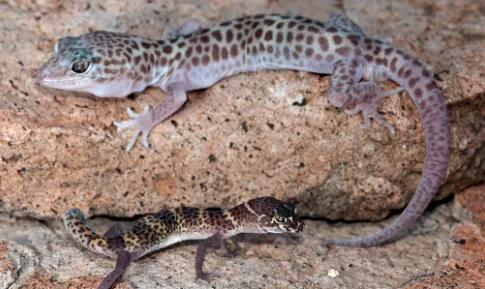
Scientific Information
- Scientific Name: Coleonyx reticulatus
- Common Names: Reticulate Banded Gecko
Origins and Habitats
Native to the southwestern parts of the United States and northwestern Mexico, particularly regions of Texas and Sonora. These geckos are commonly found in arid regions with loose, sandy soils, especially in scrublands and desert terrains.
Physical Characteristics
Size:
- Male: Average size is about 3-4 inches.
- Female: Slightly smaller, averaging around 2.5-3.5 inches.
Body Features:
They possess a delicate, slender body structure with granular scales, giving them a slightly rough texture. They also have large, prominent eyes adapted for nocturnal activities.
Coloration and Patterns:
As their common name suggests, they display a pattern of reticulated or net-like bands of varying shades of brown and tan. This intricate pattern helps them blend into the sandy environments and provides camouflage against predators.
Diet
The Reticulate Banded Gecko primarily feeds on small insects like crickets, beetles, and spiders. They are opportunistic hunters and may occasionally feed on other small invertebrates.
Environmental Impact
They play a crucial role in their native ecosystem by controlling the populations of the insects they feed on, thereby maintaining a balance in the
Interesting Facts
- The Reticulate Banded Gecko is nocturnal, and it’s not uncommon for them to burrow or find hiding spots during the daytime to protect themselves from the heat and potential predators.
- Their large eyes are not just for show – they don’t have eyelids and instead have a transparent scale covering the eye which they clean by licking with their tongue.
- When threatened, like many other gecko species, the Reticulate Banded Gecko can drop its tail as a defense mechanism. Over time, they can regenerate this tail, though the new one might look a bit different from the original.
2. Mediterranean House Gecko (Hemidactylus turcicus)
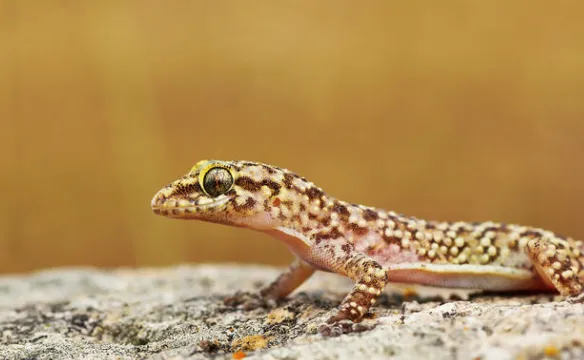
Scientific Information
- Scientific Name: Hemidactylus turcicus
- Common Names: Mediterranean House Gecko, Turkish Gecko, Moon Lizard
Origins and Habitats
As its name suggests, the Mediterranean House Gecko is native to the Mediterranean region. However, it has been introduced and has established populations in various parts of the world, including the southern United States, especially in Texas. It thrives in urban and suburban settings, frequently seen on walls, ceilings, and other structures near lights that attract their insect prey.
Physical Characteristics
Size:
- Male: Typically ranges between 3-5 inches in length.
- Female: Slightly smaller in stature, averaging around 3-4.5 inches.
Body Features:
Mediterranean House Geckos have a soft, velvety texture with small tubercles on the upper side. They possess large, lidless eyes with vertical pupils adapted for nocturnal vision.
Coloration and Patterns:
Their coloration can range from pinkish-tan to light gray. They have dark mottled patterns, which can change depending on the gecko’s mood, surroundings, or time of day. Underbelly is often translucent.
Diet
These geckos are insectivores, primarily feasting on moths, spiders, and other small insects. Their preference for staying near light sources, such as porch lights, is due to the attraction of their insect prey to these lights.
Environmental Impact
In its introduced range, like Texas, it competes with native species for resources. However, they also help in controlling insect populations in these areas, thereby acting as a natural pest controller in residential settings.
Interesting Facts
- They are known to produce a small chirping sound, especially during the mating season or when they feel threatened.
- When threatened, the Mediterranean House Gecko can drop its tail to distract predators. This tail will eventually regrow.
- Their adhesive toe pads allow them to scale vertical surfaces and even move along ceilings with ease.
3. Texas Banded Gecko (Coleonyx brevis)
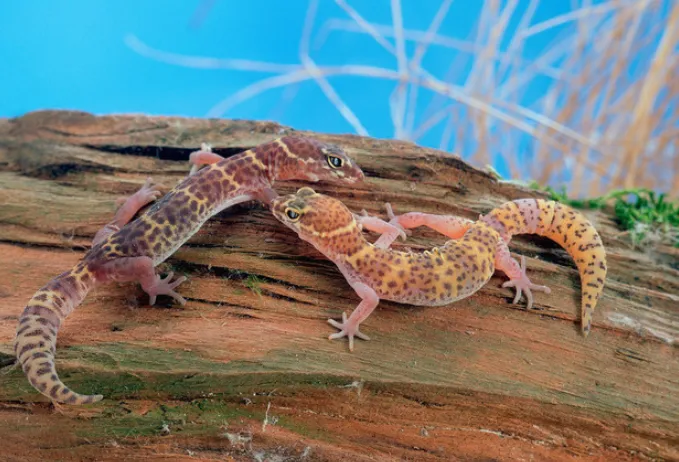
Scientific Information
- Scientific Name: Coleonyx brevis
- Common Names: Texas Banded Gecko, Texas Gecko
Origins and Habitats
The Texas Banded Gecko is native to the southwestern United States, predominantly found throughout Texas, and also extends into northern Mexico. It primarily inhabits rocky terrains, deserts, and shrublands, and often seeks refuge under rocks, logs, and other debris.
Physical Characteristics
Size:
- Male: Typically measures between 3.5-4.5 inches in length.
- Female: About the same size as males, ranging from 3.5-4.5 inches.
Body Features:
The Texas Banded Gecko possesses a slender and delicate body with a tapering tail. They have large, expressive eyes without eyelids, typical of geckos.
Coloration and Patterns:
Their background color is usually a pale gray or cream, adorned with darker bands or ringed patterns. This banding is typically more pronounced in younger geckos and may fade or become irregular as the gecko matures.
Diet
This gecko is an insectivore, preying primarily on small insects, such as beetles, spiders, and crickets. They often hunt at night, using their keen sense of sight to spot prey.
Environmental Impact
As native species, Texas Banded Geckos play an essential role in their ecosystem. They help control insect populations and serve as prey for larger animals, including snakes and some nocturnal mammals.
Interesting Facts
- When threatened, Texas Banded Geckos can drop their tail as a defense mechanism. This “autotomy” serves as a distraction for predators, allowing the gecko to escape. Over time, they can regenerate a new tail.
- They are primarily nocturnal, staying hidden during the day and becoming more active during the cooler nighttime hours.
- Texas Banded Geckos have been observed licking their eyes to keep them clean, as they lack eyelids.
4. Texas Alligator Lizard (Gerrhonotus infernalis)
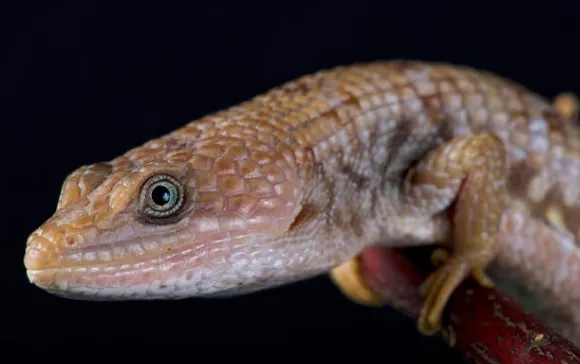
Scientific Information
- Scientific Name: Gerrhonotus infernalis
- Common Names: Texas Alligator Lizard, Infernal Alligator Lizard
Origins and Habitats
The Texas Alligator Lizard is endemic to the southwestern United States, predominantly residing in Texas. They can also be found in parts of Mexico. These lizards prefer rocky terrains, woodland clearings, and areas with dense vegetation. They often seek refuge in rock crevices, under bark, or amongst leaf litter.
Physical Characteristics
Size:
- Male: Typically measures between 10-14 inches in length, inclusive of the tail.
- Female: Slightly smaller than males, generally ranging from 9-13 inches.
Body Features:
The Texas Alligator Lizard has a robust and elongated body. Their legs are short, making their movement appear somewhat snake-like. Their dorsal scales are rough and keeled, resembling the skin of an alligator, from which they get their common name.
Coloration and Patterns:
The background color is usually a gray to brown, with darker crossbands. These bands can sometimes be broken up, appearing more as blotches. The belly is typically paler, often whitish or cream-colored.
Diet
Their diet primarily consists of insects, spiders, and other small invertebrates. Occasionally, they might consume small vertebrates if the opportunity arises.
Environmental Impact
As a native species to its range, the Texas Alligator Lizard plays a vital role in the ecosystem. They help in regulating insect populations and serve as
Interesting Facts
- Unlike many other lizards, Texas Alligator Lizards give birth to live young instead of laying eggs.
- When threatened, they may emit a foul-smelling musk to deter predators.
- The “infernalis” in their scientific name translates to “of the underworld” or “infernal,” possibly a reference to their secretive, ground-dwelling habits.
5. Keeled Earless Lizard (Holbrookia propinqua)
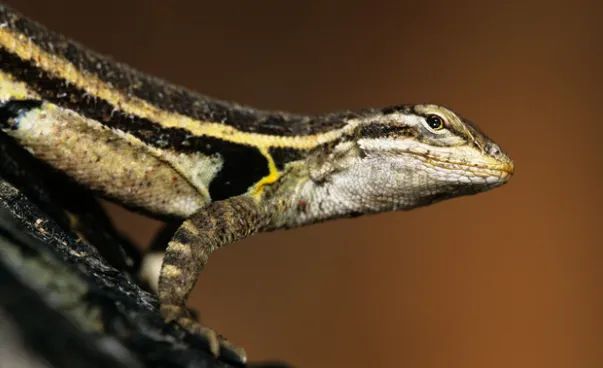
Scientific Information
- Scientific Name: Holbrookia propinqua
- Common Names: Keeled Earless Lizard
Origins and Habitats
The Keeled Earless Lizard is native to the southwestern United States, specifically in Texas. Its habitat primarily consists of sandy and rocky terrains, grasslands, and brushy areas, often in regions with arid climates.
Physical Characteristics
Size:
- Male: Typically measures between 4.5-5.5 inches in length, inclusive of the tail.
- Female: Comparable in size to males, but can sometimes be slightly larger.
Body Features:
As its name implies, the Keeled Earless Lizard lacks external ear openings. They have a flattened body with a distinctively keeled dorsal scale, which gives them a rough texture.
Coloration and Patterns:
They exhibit a gray or brownish background color with darker spots or blotches. Males may possess blue patches on the sides of their belly.
Diet
The Keeled Earless Lizard’s diet is insectivorous. They primarily feed on ants, beetles, spiders, and other small invertebrates.
Environmental Impact
Being a native species to their range, Keeled Earless Lizards are an integral part of their ecosystem. They help control insect populations, and in turn, are a
Interesting Facts
- Their lack of external ears is believed to be an adaptation to prevent sand from entering while they burrow or dig.
- During the breeding season, males exhibit more vibrant colorations to attract females.
- When threatened, they might inflate their bodies to appear larger and more intimidating to potential predators.
6. Greater Earless Lizard (Cophosaurus texanus)
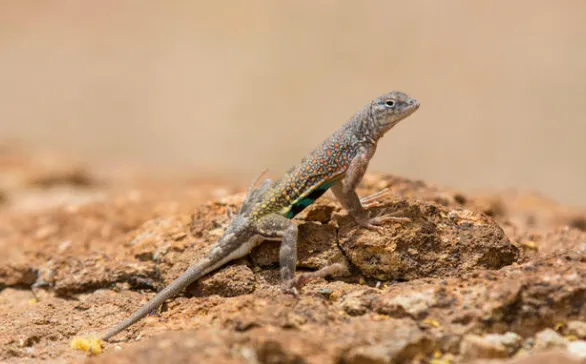
Scientific Information
- Scientific Name: Cophosaurus texanus
- Common Names: Greater Earless Lizard
Origins and Habitats
The Greater Earless Lizard is native to the southwestern United States, including large parts of Texas, and extends into Mexico. This species prefers arid habitats such as deserts, sandy plains, and rocky outcrops.
Physical Characteristics
Size:
- Male: Generally, males can reach lengths of up to 5.5 inches including their tail.
- Female: Slightly smaller than males, but sizes are relatively comparable.
Body Features:
True to its name, the Greater Earless Lizard lacks external ear openings. It has a slim, elongated body structure and long, slender legs which aid in rapid movement.
Coloration and Patterns:
Their coloration can vary but generally consists of a gray to sandy background with darker patterns or stripes. Males might display bright blue patches on their undersides during the breeding season.
Diet
Greater Earless Lizards are primarily insectivorous, preying on a range of insects including ants, beetles, and grasshoppers. Their diet may occasionally include small invertebrates.
Environmental Impact
As a native species, they play a role in controlling insect populations within their habitats. At the same time, they serve as prey for various predators like birds, snakes, and larger reptiles.
Interesting Facts
- Their lack of external ears is believed to be an evolutionary adaptation to their sandy habitats, preventing sand from getting inside while they’re burrowing.
- These lizards are known for their quick and agile movements, often darting into the shadows or under rocks when threatened.
- When trying to impress a potential mate or intimidate a rival, males will do push-ups to showcase their vibrant blue patches.
7. Common Lesser Earless Lizard (Holbrookia maculate)
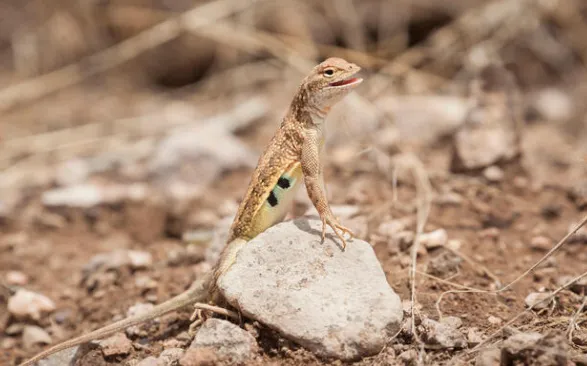
Scientific Information
- Scientific Name: Holbrookia maculata
- Common Names: Common Lesser Earless Lizard, Lesser Earless Lizard
Origins and Habitats
Native to the southwestern United States, the Common Lesser Earless Lizard is particularly found in parts of Texas, New Mexico, Oklahoma, and extends into northern Mexico. They typically inhabit arid to semi-arid regions, often found in sandy or loamy soils with sparse vegetation.
Physical Characteristics
Size:
- Male: Typically, males can measure up to 4 inches snout-to-vent length.
- Female: They are slightly smaller than males but are generally comparable in size.
Body Features:
As their name suggests, these lizards lack external ear openings. They have a flattened body structure which is an adaptation to their ground-dwelling nature. Their legs are relatively short, but they are still agile movers.
Coloration and Patterns:
Their dorsal side varies from gray to brown with distinctive dark spots. The spots can sometimes be aligned to form partial bands across the back. During the breeding season, males may display colorful patches, usually orange or blue, on their throats and sides.
Diet
They primarily feed on insects, including beetles, ants, and spiders. Their diet might occasionally expand to other small invertebrates.
Environmental Impact
As native species, they play a role in their ecosystem by controlling insect populations. They are also a
Interesting Facts
- The “earless” aspect of their name, similar to other earless lizards, likely evolved to prevent sand and dirt from entering their bodies as they live and burrow in sandy environments.
- When threatened, they might run swiftly to the nearest shelter or play dead to avoid detection.
- Their flattened bodies allow them to “swim” through soft sand, helping them escape from predators.
8. Reticulate Collared Lizard (Crotaphytus reticulatus)
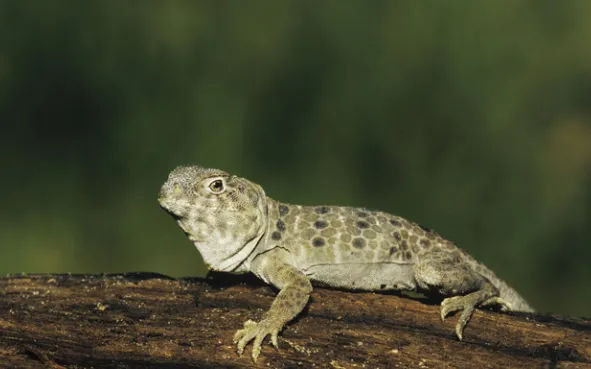
Scientific Information
- Scientific Name: Crotaphytus reticulatus
- Common Names: Reticulate Collared Lizard, Netted Collared Lizard
Origins and Habitats
The Reticulate Collared Lizard is native to the southern United States, specifically Texas, and northeastern Mexico. Preferring arid habitats, they often inhabit rocky outcrops, scrublands, and open grasslands with sparse vegetation.
Physical Characteristics
Size:
- Male: Males are generally larger and can reach lengths of up to 11 inches including the tail.
- Female: Slightly smaller than males, they can reach lengths of up to 9 inches, tail included.
Body Features:
Collared lizards have a robust body structure with long, powerful hind limbs, which they occasionally use to run bipedally. Their head is distinctively large, and as with many lizards, males have a more pronounced jawline.
Coloration and Patterns:
The lizard’s base color is typically a light tan or gray, adorned with a complex pattern of darker reticulations, hence its name. Males often exhibit bright blue or green coloration on their bodies, especially during the breeding season.
Diet
They are carnivorous, feeding primarily on insects like grasshoppers and beetles, but they won’t hesitate to eat smaller lizards when given the chance.
Environmental Impact
As predators, they play an essential role in controlling insect populations in their habitats. At the same time, they serve as prey to larger predators such as birds of prey and snakes. Their presence indicates a balanced ecosystem.
Interesting Facts
- They have the capability to run on their hind legs, especially when they’re trying to escape from predators or when chasing after prey. This bipedal run gives them an appearance similar to tiny theropod dinosaurs.
- The “collared” in their name comes from the distinct black bands present on the back of their neck.
- During mating season, the coloration of males becomes particularly vibrant to attract females and ward off rival males.
9. Eastern Collared Lizard (Crotaphytus collaris)
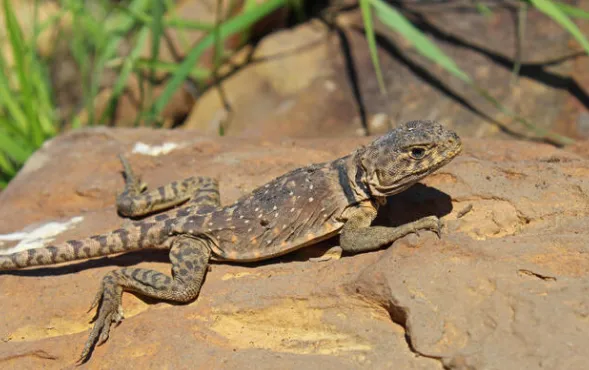
Scientific Information
- Scientific Name: Crotaphytus collaris
- Common Names: Eastern Collared Lizard, Common Collared Lizard, Mountain Boomer
Origins and Habitats
The Eastern Collared Lizard is native to the central and southwestern United States, spanning from Missouri and Arkansas westward to parts of California and as far south as northern Mexico. They’re usually found in arid regions, particularly rocky outcrops, scrublands, and open grasslands.
Physical Characteristics
Size:
- Male: Males are typically larger, often reaching lengths of up to 14 inches including the tail.
- Female: Usually smaller than males, they can be up to 10 inches in length, tail included.
Body Features:
The lizard possesses a stout body with robust limbs. It has a pronounced head, and, in males, a noticeable jawline. The long tail and powerful legs allow it to be quite agile in its rocky surroundings.
Coloration and Patterns:
The Eastern Collared Lizard is renowned for its striking coloration, with males displaying vibrant blues and greens, especially during mating season. Their name derives from the two black collars around their neck. Females are usually a light brown or gray color with some banding but can display hints of blue or green.
Diet
Predominantly carnivorous, the Eastern Collared Lizard feeds on a variety of insects, spiders, and even smaller lizards.
Environmental Impact
They play a role in managing insect populations, helping to keep a balance in their native habitats. On the flip side, they are prey for larger predators, including birds of prey, larger reptiles, and mammals.
Interesting Facts
- Their alternate name, “Mountain Boomer,” isn’t related to any sound they make but is an old folk name derived from their prevalent presence in mountainous areas.
- Much like their close relatives, they can run on their hind legs when threatened or in pursuit of prey.
- During the breeding season, males engage in fierce territorial disputes, often resorting to biting.
10. Brown Anole (Anolis sagrei)
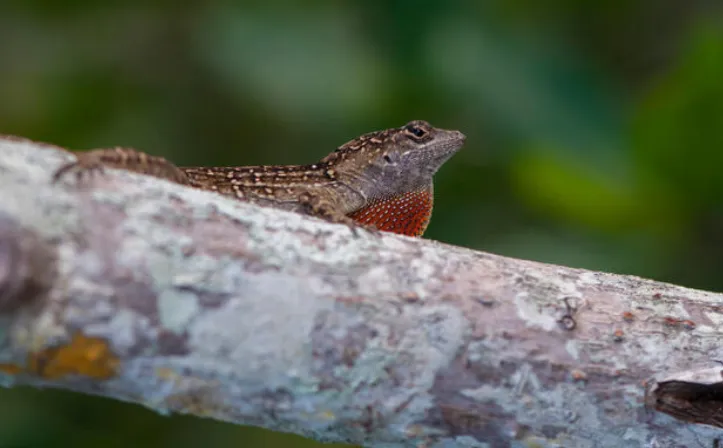
Scientific Information
- Scientific Name: Anolis sagrei
- Common Names: Brown Anole
Origins and Habitats
The Brown Anole is originally native to the Bahamas and Cuba. However, it has successfully established itself in various parts of the southeastern United States, most notably in Florida. Its adaptability has made it a familiar sight in urban gardens, parks, and forests.
Physical Characteristics
Size:
- Male: Males are generally larger, often reaching lengths of up to 8 inches including the tail.
- Female: Females are typically smaller and can be up to 6 inches in length, tail included.
Body Features:
The Brown Anole possesses a slender body and a pointed snout. Males have a pronounced dewlap, a flap of skin under their throats, which they extend for display during mating or territorial confrontations.
Coloration and Patterns:
While their primary color is brown, Brown Anoles have the ability to exhibit a certain degree of color variation, shifting between different shades of brown to match their surroundings. They often possess a lighter stripe or series of spots down their back.
Diet
Being opportunistic feeders, Brown Anoles primarily consume insects like crickets, beetles, and moths. They also have been known to eat spiders and, occasionally, smaller lizards or even their own eggs.
Environmental Impact
The introduction of the Brown Anole, especially in places like Florida, has had a significant impact on native species, particularly the Green Anole. Due to the Brown Anole’s aggressive nature, it often outcompetes the Green Anole for resources, pushing the latter to higher, less familiar grounds. However, they also help control insect populations in the areas they inhabit.
Interesting Facts
- Brown Anoles are known to “bob” their heads up and down, particularly during confrontational displays.
- Their rapid colonization of Florida is a classic example of how species can become invasive when introduced to new territories without natural predators.
- Brown Anoles can regenerate their tails if they lose them to a predator, although the new tail will be slightly different in appearance.
11. Green Anole (Anolis carolinensis)
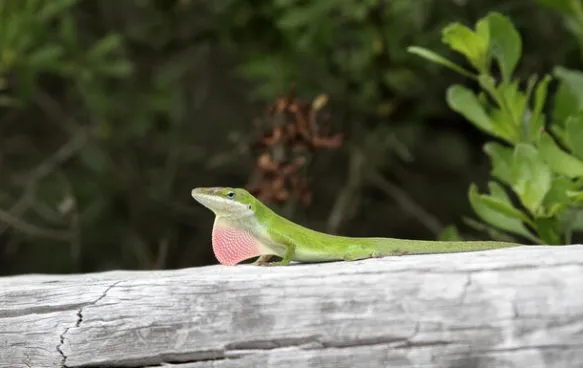
Scientific Information
- Scientific Name: Anolis carolinensis
- Common Names: Green Anole, Carolina Anole, American Anole
Origins and Habitats
The Green Anole is native to the southeastern United States, ranging from Texas to Florida and northward to North Carolina. These lizards inhabit a variety of environments, from forests and woodlands to urban gardens and parks. They are particularly prominent in warm, humid environments.
Physical Characteristics
Size:
- Male: Males typically range from 5 to 8 inches in length, with the tail accounting for about two-thirds of that measurement.
- Female: Females are slightly smaller than males, usually measuring between 4 to 7 inches in length.
Body Features:
The Green Anole has a slender body structure with a long tail. It also boasts adhesive pads on its toes, which help it move effortlessly among trees and plants. Males have a dewlap, a colorful throat fan, which they display to attract females or deter rivals.
Coloration and Patterns:
The Green Anole is predominantly bright green, but it has the unique ability to change its color to shades of brown or gray. This ability is influenced by various factors, including mood, health, and environmental conditions, leading to its occasional nickname: the “American chameleon”.
Diet
Their primary diet consists of insects, such as crickets, beetles, and flies. They are also known to consume spiders and other small invertebrates. The sticky, extendable tongue of the Green Anole aids in swiftly catching their prey.
Environmental Impact
The Green Anole serves as an essential component of its ecosystem. While it helps regulate insect populations, it also serves as prey for larger predators, such as birds and snakes. However, their status in some parts of their native habitats, especially Florida, is under threat due to the invasive Brown Anole, which competes for the same resources.
Interesting Facts
- The Green Anole is occasionally, albeit incorrectly, termed the “American chameleon” due to its color-changing abilities.
- Unlike many lizards, Green Anoles are known to be active during the daytime.
- They have a social structure and communicate using body language, especially the males, who may show off their dewlaps or perform push-ups to assert dominance.
12. Ornate Tree Lizard (Urosaurus ornatus)
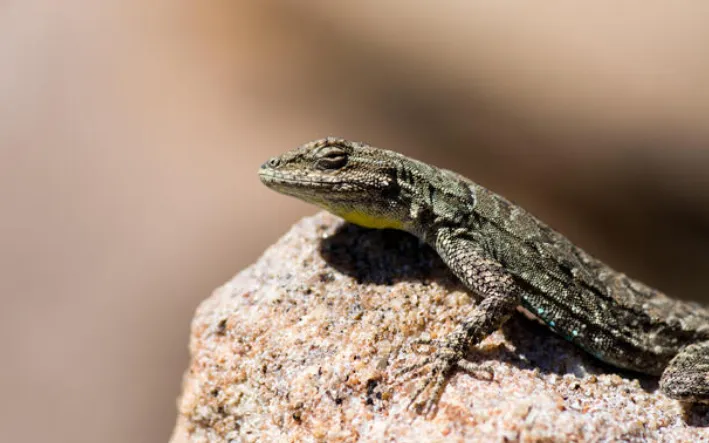
Scientific Information
- Scientific Name: Urosaurus ornatus
- Common Names: Ornate Tree Lizard, Ornate Uta
Origins and Habitats
The Ornate Tree Lizard is native to the southwestern United States and northwestern Mexico. Its preferred habitats include rocky canyons, cliffs, and arid scrublands. As the name suggests, these lizards often spend their time in trees, shrubs, and other vertical surfaces.
Physical Characteristics
Size:
- Male: Males can range from 2 to 2.8 inches in snout-to-vent length.
- Female: Females tend to be slightly smaller, ranging from 1.8 to 2.5 inches in snout-to-vent length.
Body Features:
The Ornate Tree Lizard has a slender body and a long tail. Its toes are equipped with adhesive scales, aiding in climbing.
Coloration and Patterns:
Their dorsal surface generally exhibits a grayish-brown to greenish color with an intricate pattern of dark, wavy crossbands and light spots. Males usually display blue patches on their bellies and throats.
Diet
The diet of the Ornate Tree Lizard primarily consists of small insects and arthropods, including ants, beetles, and spiders.
Environmental Impact
Serving as both predator and prey within their ecosystem, the Ornate Tree Lizard helps regulate insect populations and provides a
Interesting Facts
- The Ornate Tree Lizard is known to bask openly but will quickly scuttle to cover if disturbed, showcasing its agile climbing skills.
- During mating seasons, males will do display behaviors, like push-ups, to attract females and deter rival males.
- They have the ability to detach their tails when threatened by predators, a common defensive tactic among many lizard species.
13. Common Side-Blotched Lizard (Uta stansburiana)
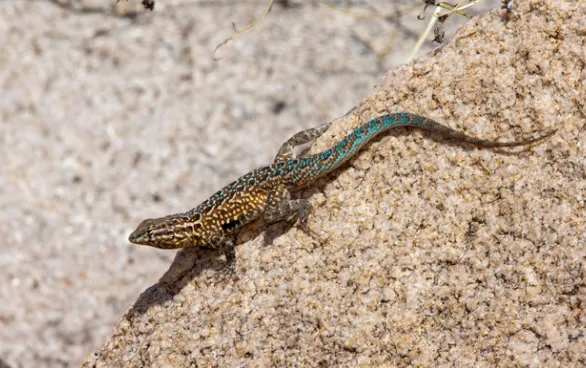
Scientific Information
- Scientific Name: Uta stansburiana
- Common Names: Common Side-Blotched Lizard, Side-Blotched Lizard
Origins and Habitats
The Common Side-Blotched Lizard is native to the western United States and northern Mexico. Their habitats range from sea level up to 10,800 feet, spanning deserts, shrublands, and grasslands. Their adaptability to a variety of habitats contributes to their widespread distribution.
Physical Characteristics
Size:
- Male: Typically, males measure between 1.5 to 2.3 inches in snout-to-vent length.
- Female: Females are roughly the same size, ranging between 1.4 to 2.2 inches in snout-to-vent length.
Body Features:
This lizard is known for the characteristic dark blotch behind its front leg, from which it derives its name. It has a flattened body, which assists in burrowing into the sand and escaping predators.
Coloration and Patterns:
These lizards have a variety of color morphs, including orange, yellow, and blue. The coloration is linked to their unique mating system and behaviors. The dorsal side often has a pattern of small spots or reticulations.
Diet
Common Side-Blotched Lizards primarily feed on small insects, including ants, beetles, and spiders. They’re also known to consume some plant material occasionally.
Environmental Impact
They serve an essential role in their ecosystem by keeping insect populations in check. At the same time, they act as a
Interesting Facts
- One of the most fascinating aspects of the Common Side-Blotched Lizard is its unique mating system. There are three different male color morphs: orange-throated, blue-throated, and yellow-throated. Each has different reproductive strategies and behaviors.
- These lizards use rapid push-up movements to communicate with rivals or potential mates.
- They have a short lifespan, often living only one to three years in the wild.
14. Long-Nosed Leopard Lizard (Gambelia wislizenii)
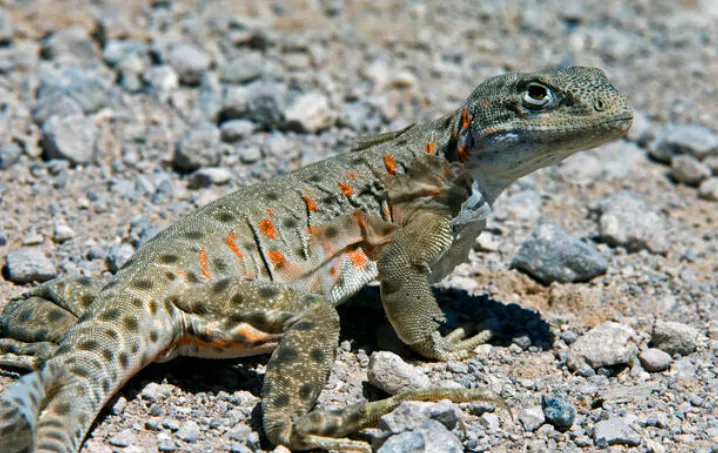
Scientific Information
- Scientific Name: Gambelia wislizenii
- Common Names: Long-Nosed Leopard Lizard
Origins and Habitats
The Long-Nosed Leopard Lizard is native to the arid regions of the western United States and northern Mexico. They are commonly found in desert flats, sand dunes, and sagebrush, especially in areas with open ground which they use for hunting and basking.
Physical Characteristics
Size:
- Male: Males typically measure between 3 to 4.5 inches in snout-to-vent length.
- Female: Females are larger, ranging from 4 to 5.5 inches in snout-to-vent length.
Body Features:
This lizard has a relatively long snout, which gives it its name. It has a robust and slightly flattened body with long, muscular legs, allowing for rapid movement.
Coloration and Patterns:
Their base color is usually gray or cream, overlaid with dark spots and crossbands. When females are gravid (carrying eggs), they can display vibrant orange-red spots, making them particularly striking in appearance.
Diet
Long-Nosed Leopard Lizards have a varied diet that includes insects, spiders, smaller lizards, and sometimes even small mammals. Their hunting strategy is a mix of active chasing and ambush.
Environmental Impact
As predators, they help control the populations of smaller animals, maintaining a balance in their ecosystem. In turn, they act as prey for larger predators like birds of prey and snakes.
Interesting Facts
- When threatened, the Long-Nosed Leopard Lizard might run swiftly on its hind legs, a behavior that’s interesting to observe.
- They have the capability to shed (autotomize) their tail as a defensive mechanism. The tail continues to wiggle, distracting potential predators, while the lizard makes its escape. Over time, they can regenerate a new tail, though it’s often shorter and differently colored than the original.
- Gravid females with their vivid coloration are known to be more aggressive, likely as a protective measure for their unborn offspring.
15. Slender Glass Lizard (Ophisaurus attenuates)
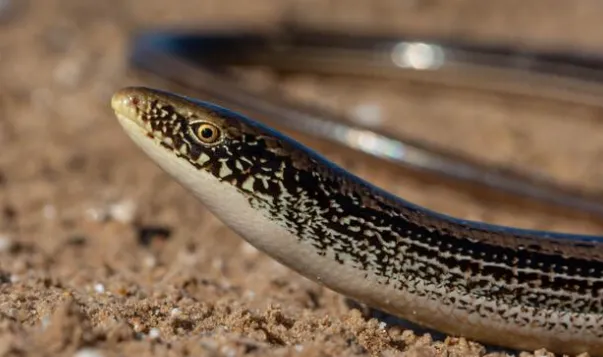
Scientific Information
- Scientific Name: Ophisaurus attenuatus
- Common Names: Slender Glass Lizard, Slender Legless Lizard
Origins and Habitats
Native to the southeastern United States, the Slender Glass Lizard prefers grassy habitats, open woodlands, and the edges of forests. They tend to thrive in areas with sandy or loose soil where they can easily burrow.
Physical Characteristics
Size:
- Male: Typically measure between 20 to 28 inches in length.
- Female: Roughly the same size as males, but can sometimes be slightly larger.
Body Features:
Although they might look like snakes at first glance due to their legless nature, glass lizards are indeed lizards. One key difference is that they have movable eyelids and external ear openings, which snakes lack.
Coloration and Patterns:
The Slender Glass Lizard is usually a golden brown or olive color with dark longitudinal lines down its body. Their underbelly is generally pale yellow or white.
Diet
Their diet consists primarily of insects, spiders, and other small invertebrates. They are known to also eat small reptiles and reptile eggs occasionally.
Environmental Impact
They play a role in controlling insect and spider populations in their habitats. Predators like snakes, birds, and even larger mammals can prey on them, placing the Slender Glass Lizard in the middle of the
Interesting Facts
- Their name “glass lizard” stems from their ability to break off a part of their tail when threatened. This tail breakage can be so smooth that it looks like a piece of broken glass. The tail, once dropped, will twitch and distract potential predators, allowing the lizard to escape.
- Even though they are legless, their skeletal structure still retains remnants of pelvic and shoulder girdles.
- Like other reptiles, they lay eggs, and the females will often guard their nest sites.
16. Round-Tailed Horned Lizard (Phrynosoma modestum)
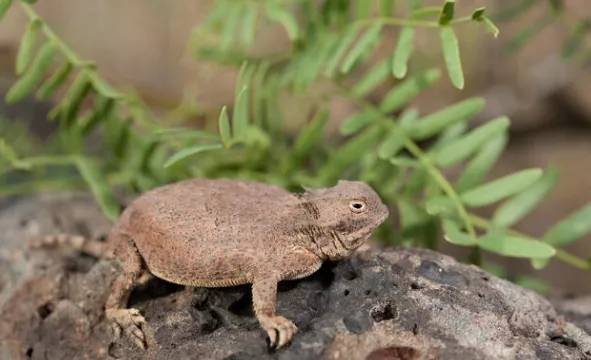
Scientific Information
- Scientific Name: Phrynosoma modestum
- Common Names: Round-Tailed Horned Lizard, Modest Horned Lizard
Origins and Habitats
The Round-Tailed Horned Lizard is native to the southwestern United States, primarily found in Texas, as well as parts of Mexico. They predominantly inhabit arid and semi-arid regions with loose sandy or loamy soils, including deserts, grasslands, and rocky outcrops.
Physical Characteristics
Size:
- Male: Typically measure between 2.5 to 3.5 inches in length.
- Female: Generally the same size as males but might be slightly larger during the breeding season.
Body Features:
The Round-Tailed Horned Lizard has a flattened, round body with a characteristic row of spines or “horns” running down the back of its head, resembling a mini-dinosaur. Their tails are notably rounded, distinguishing them from other horned lizards.
Coloration and Patterns:
Their coloration is usually a mix of brown, gray, and cream, which provides excellent camouflage against the sandy and rocky backgrounds of their habitats. The dorsal side can have darker spots or patterns, further aiding in their disguise.
Diet
The primary diet of the Round-Tailed Horned Lizard consists of ants, but they also consume beetles, termites, and other small invertebrates.
Environmental Impact
By feeding on ants and other insects, they help maintain a balance in the insect populations of their habitats. However, they are also a
Interesting Facts
- One of the unique defense mechanisms of horned lizards is their ability to squirt blood from their eyes when threatened by predators. This behavior can deter potential attackers.
- Despite their intimidating appearance with spines and horns, they are harmless to humans.
- The decline in their populations in some regions is often attributed to habitat destruction and the widespread use of pesticides which reduce ant populations, their primary
food source.
17. Greater Short-Horned Lizard (Phrynosoma hernandesi)
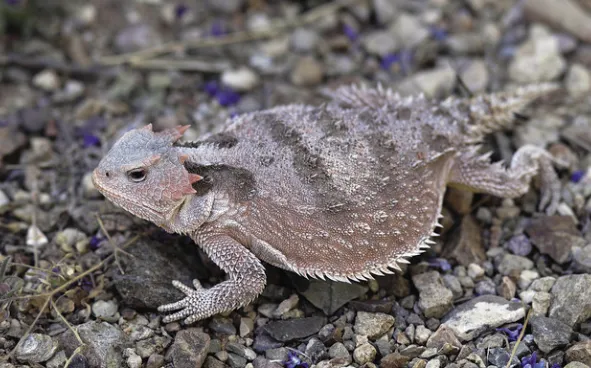
Scientific Information
- Scientific Name: Phrynosoma hernandesi
- Common Names: Greater Short-Horned Lizard, Mountain Short-Horned Lizard
Origins and Habitats
Native to the western United States, the Greater Short-Horned Lizard can be found in various habitats ranging from arid deserts to mountain meadows. They are particularly prevalent in areas with loose or sandy soil which facilitates their burrowing behavior.
Physical Characteristics
Size:
- Male: Typically measuring between 2.5 to 4.5 inches in length.
- Female: Slightly larger than males, averaging around 3 to 5 inches in length.
Body Features:
This lizard has a wide, flattened body with short, stubby horns on its head, in contrast to the longer horns of some related species. Their limbs are robust, and they have a short, broad snout.
Coloration and Patterns:
Their coloration can range from brown and gray to rust-red or even olive, often with dark blotches or patterns on the dorsal side. This coloration offers them excellent camouflage in their natural habitats.
Diet
Ants make up a significant portion of their diet, but they also consume beetles, spiders, and other small invertebrates.
Environmental Impact
The Greater Short-Horned Lizard, by feeding on insects, plays a role in controlling pest populations. They also act as prey for various predators, including snakes, larger lizards, birds, and mammals.
Interesting Facts
- Like other horned lizards, the Greater Short-Horned Lizard has the astounding ability to squirt blood from its eyes as a defense mechanism against predators.
- Their body shape and coloration allow them to remain virtually invisible in their environment, often burying themselves in the sand with only their eyes and the tops of their heads exposed.
- The lizard has an unusual adaptation to conserve water; it can collect rainwater or dew on its back and channel it to its mouth through grooves between its scales.
18. Texas Horned Lizard (Phrynosoma cornutum)
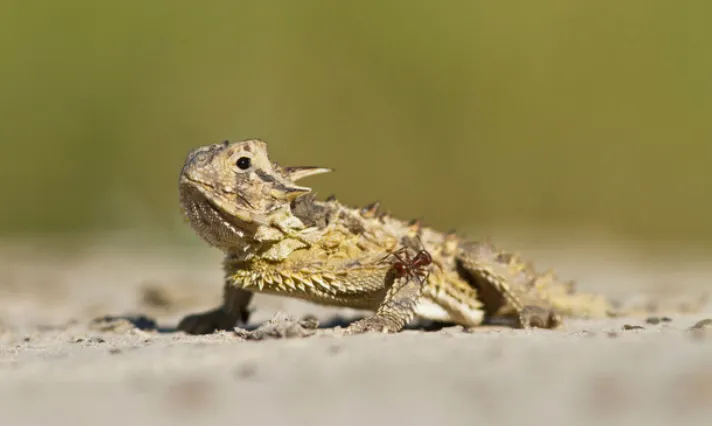
Scientific Information
- Scientific Name: Phrynosoma cornutum
- Common Names: Texas Horned Lizard, Horned Toad, Horny Toad
Origins and Habitats
The Texas Horned Lizard is native to the central United States, primarily found in Texas, but its range extends into surrounding states and Mexico. They inhabit arid and semiarid regions, preferring open areas with loose soil where they can easily burrow, such as grasslands, deserts, and plains.
Physical Characteristics
Size:
- Male: Usually around 2.5 to 3.5 inches in length.
- Female: Typically larger, ranging from 3 to 4 inches in length.
Body Features:
As their name suggests, Texas Horned Lizards possess distinct horn-like spines on their heads. Their body is flat and wide, making them look somewhat like a miniature dinosaur or dragon.
Coloration and Patterns:
Their coloration varies from reddish-brown to gray, with dark spots across the back and sides, allowing them to blend seamlessly with their environment.
Diet
Ants, particularly harvester ants, constitute a significant portion of their diet. However, they also eat beetles, termites, and other small insects.
Environmental Impact
As insectivores, they help regulate insect populations, especially ants. However, they themselves are prey for a variety of animals, from snakes and birds to larger mammals, adding to the
Interesting Facts
- When threatened, the Texas Horned Lizard can squirt a stream of blood from its eyes to deter predators—a unique and startling defense mechanism.
- Populations of the Texas Horned Lizard have declined in certain areas, leading to conservation efforts and their listing as a threatened species in some states.
- These lizards have the ability to inflate themselves when threatened, making it harder for predators to swallow them.
19. Little Brown Skink (Scincella lateralis)
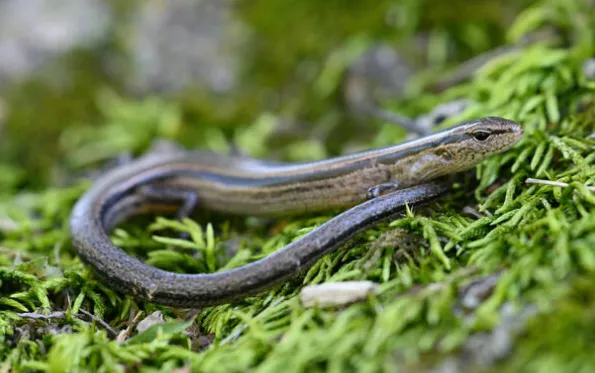
Scientific Information
- Scientific Name: Scincella lateralis
- Common Names: Little Brown Skink, Ground Skink
Origins and Habitats
The Little Brown Skink is native to the southeastern and central United States, including Texas. Its habitat spans woodlands, grasslands, and backyard gardens, usually in areas with plenty of ground cover and loose, moist soil where they can burrow or hide under leaf litter.
Physical Characteristics
Size:
- Male: Typically measures around 3 to 4.5 inches in length.
- Female: Similar in size to males, around 3 to 4.5 inches.
Body Features:
This lizard has a slender, elongated body with small legs, which gives it a snake-like appearance. Its head is small and somewhat flattened.
Coloration and Patterns:
As its name suggests, the Little Brown Skink is predominantly brown in color. It might have a faint stripe down its back and, sometimes, dark sides, which can help it blend into its surroundings.
Diet
They primarily feed on small insects such as ants, beetles, and spiders.
Environmental Impact
The Little Brown Skink plays a role in controlling insect populations in its habitat. Their presence also provides a
Interesting Facts
- When threatened, the Little Brown Skink can detach its tail to distract predators. Over time, they can regenerate a new tail.
- Their legs are so small and their movements so fluid, they almost seem to “swim” through leaf litter.
- These skinks have evolved to have smooth, shiny scales which allow them to move efficiently through grass and under leaves, making them proficient ground dwellers.
20. Southern Prairie Skink (Plestiodon obtusirostris)
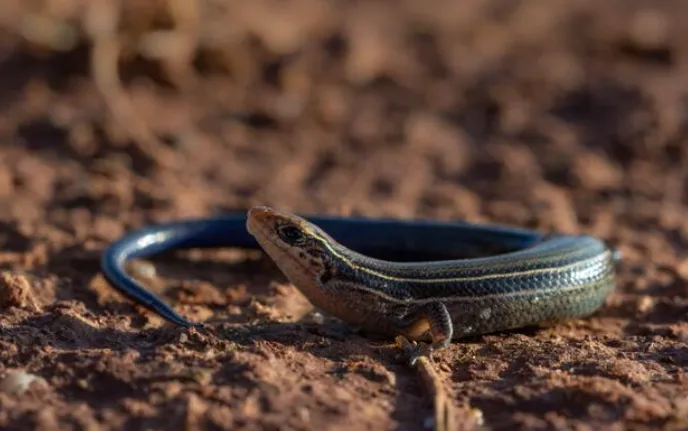
Scientific Information
- Scientific Name: Plestiodon obtusirostris
- Common Names: Southern Prairie Skink
Origins and Habitats
The Southern Prairie Skink is found in the central regions of the United States, including parts of Texas. They predominantly inhabit grasslands, prairies, and open woodlands, preferring areas with sandy or loose soil that allows them to burrow and hide.
Physical Characteristics
Size:
- Male: Typically measures around 4 to 5.5 inches in length.
- Female: Slightly smaller than males, generally measuring between 3.5 to 5 inches.
Body Features:
The Southern Prairie Skink has a robust and elongated body with well-developed legs. Their heads are broad and blunt, with a pronounced snout.
Coloration and Patterns:
They possess a brownish or tan base color with darker, often parallel, stripes running down the length of their body. These patterns and colorations help them blend into their prairie environments.
Diet
These skinks primarily eat a variety of insects, including beetles, crickets, and spiders. They also consume other small invertebrates.
Environmental Impact
As insectivores, Southern Prairie Skinks help control insect populations, thus maintaining a balance in their native habitats. Furthermore, they serve as prey for numerous predators, such as larger reptiles, birds, and mammals.
Interesting Facts
- When in danger, the Southern Prairie Skink, like many other skinks, can drop its tail as a defense mechanism to distract predators. The tail will wiggle, drawing the predator’s attention, while the skink makes its escape. Over time, they can grow a new tail, though it might not be as long as the original.
- The Southern Prairie Skink is also known to perform a “push-up” display, a series of up and down body movements, possibly to communicate or mark territory.
21. Broad-Headed Skink (Plestiodon laticeps)
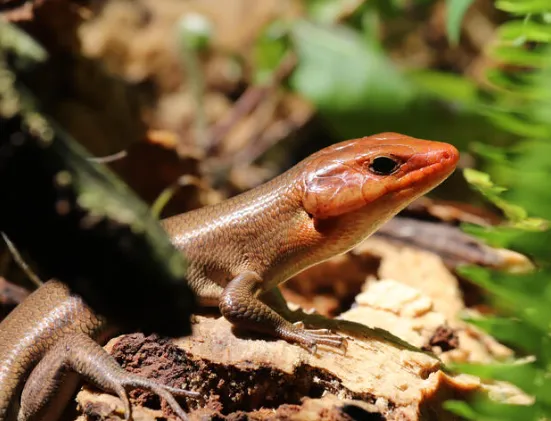
Scientific Information
- Scientific Name: Plestiodon laticeps
- Common Names: Broad-Headed Skink
Origins and Habitats
The Broad-Headed Skink is native to the southeastern regions of the United States, including parts of Texas. Their preferred habitats include deciduous forests, especially those with abundant rotting logs and leaf litter. They’re often found in wooded areas with plenty of undergrowth, as these conditions offer shelter and hunting grounds.
Physical Characteristics
Size:
- Male: Males can measure between 6.5 to 13 inches, with the broadest heads among Plestiodon species.
- Female: Typically smaller, measuring between 5 to 9 inches.
Body Features:
The Broad-Headed Skink has a robust body with smooth, shiny scales. Males have especially wide jaws and heads, which become even more pronounced and reddish during the breeding season.
Coloration and Patterns:
Juveniles are strikingly patterned with five white or yellowish stripes on a dark background. As they mature, especially males, the stripes may fade, and their body takes on a more uniform color, often with an olive or brown hue. Males, during breeding season, can also display bright orange-red heads.
Diet
Their diet is varied, consisting of insects, spiders, smaller lizards, and even small rodents or bird eggs when available.
Environmental Impact
Broad-Headed Skinks play a crucial role in controlling insect and spider populations in their habitats, which aids in maintaining a balanced ecosystem. They also serve as prey for various predators, such as snakes, larger birds, and mammals.
Interesting Facts
- The Broad-Headed Skink, due to its larger size and varied diet, is one of the few skinks known to occasionally eat small vertebrates.
- During the breeding season, males will engage in aggressive combat for the right to mate with females, using their broad heads to try and overpower rivals.
- Their smooth, overlapping scales give them a particularly shiny appearance, which can sometimes lead to them being mistaken for salamanders at a quick glance.
22. Common Five-Lined Skink (Plestiodon fasciatus)
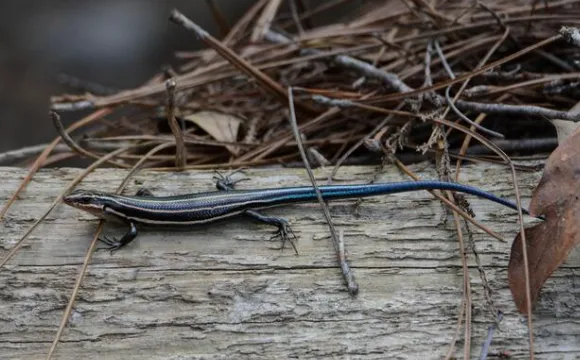
Scientific Information
- Scientific Name: Plestiodon fasciatus
- Common Names: Common Five-Lined Skink, Blue-Tailed Skink (for juveniles)
Origins and Habitats
The Common Five-Lined Skink is native to the eastern United States, stretching from the Great Lakes down to northern Florida and as far west as Texas. They prefer woodlands, forest edges, and grassy or rocky open areas. These skinks are often found under logs, rocks, and other debris where they can easily hide from predators.
Physical Characteristics
Size:
- Male: Typically around 5 to 8.5 inches in length.
- Female: Slightly smaller, usually around 5 to 7.5 inches in length.
Body Features:
The body of the Common Five-Lined Skink is slender and smooth. Juveniles are notable for their bright blue tails, which fade as they mature. Males may develop orange coloring on the face during the breeding season.
Coloration and Patterns:
True to its name, this skink has five distinct light stripes running down a darker background from its head to the base of its tail. Over time, older individuals may lose this clear striping and appear more uniformly brown or gray. The vibrant blue tail of the juveniles is believed to be a defensive adaptation, drawing a predator’s attention to the tail (which can be regenerated) rather than the body.
Diet
The Common Five-Lined Skink’s diet primarily consists of insects, spiders, and other small invertebrates.
Environmental Impact
As insectivores, these skinks play an essential role in controlling insect populations, helping to maintain a balance in the ecosystem. On the flip side, they also serve as prey for various predators, such as larger birds, snakes, and certain mammals.
Interesting Facts
- If threatened, the Common Five-Lined Skink can detach its tail, allowing it to escape while the detached tail continues to wriggle, distracting the predator. Over time, the skink can regenerate its tail, though the new tail may not have the same bright coloration.
- The vibrant blue tail in juveniles fades as they age, but it remains a defining feature that many people associate with this lizard.
- While they are capable climbers, these skinks are often found on the ground, basking in the sun or foraging for
food .
23. Coal Skink (Plestiodon anthracinus)
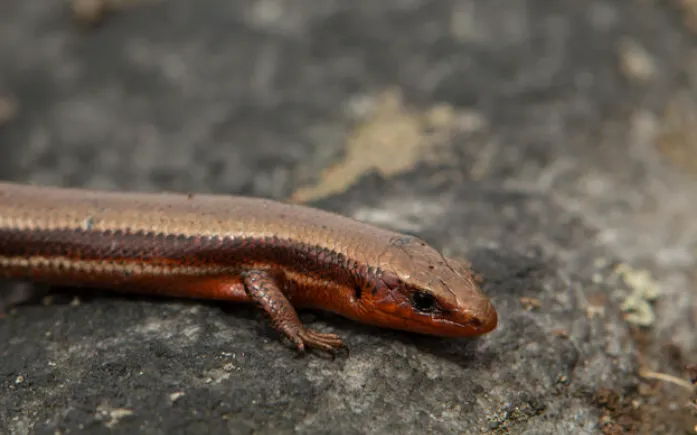
Scientific Information
- Scientific Name: Plestiodon anthracinus
- Common Names: Coal Skink
Origins and Habitats:
The Coal Skink is native to the eastern and central United States, ranging from New York to northern Florida and as far west as Texas. They are found in moist wooded areas, often near streams or other water bodies. These skinks prefer habitats with plenty of leaf litter, loose soil, and debris like logs or rocks for hiding.
Physical Characteristics:
Size:
- Male: Typically around 5 to 7 inches in length.
- Female: Similar in size, usually around 5 to 7 inches in length.
Body Features:
Coal Skinks have a streamlined body, a broad, flattened head, and short legs. Their eyelids are movable, which is a characteristic feature of skinks.
Coloration and Patterns:
Their dorsal surface is typically brown or olive with a distinctive dark stripe bordered by two lighter stripes on each side. The stripe starts from behind the eye and extends to the tail. Their belly is light-colored, usually white or pale yellow. During the breeding season, males may have bright orange jaws and a reddish-orange underside.
Diet
Coal Skinks primarily feed on small insects, arachnids, and other invertebrates.
Environmental Impact
As with many skink species, the Coal Skink plays a role in controlling insect and arachnid populations. Their presence aids in maintaining the balance of their ecosystems. They also serve as a
Interesting Facts
- Coal Skinks, when threatened, can detach their tails as a defense mechanism. This self-amputation distracts the predator, allowing the skink to escape. Over time, they can regenerate the lost tail.
- The name “Coal Skink” likely comes from the dark stripe that runs down the length of their bodies, resembling coal.
- Unlike many lizards that lay eggs, Coal Skinks give birth to live young, usually in late summer.
24 Many-Lined Skink (Plestiodon multivirgatus)
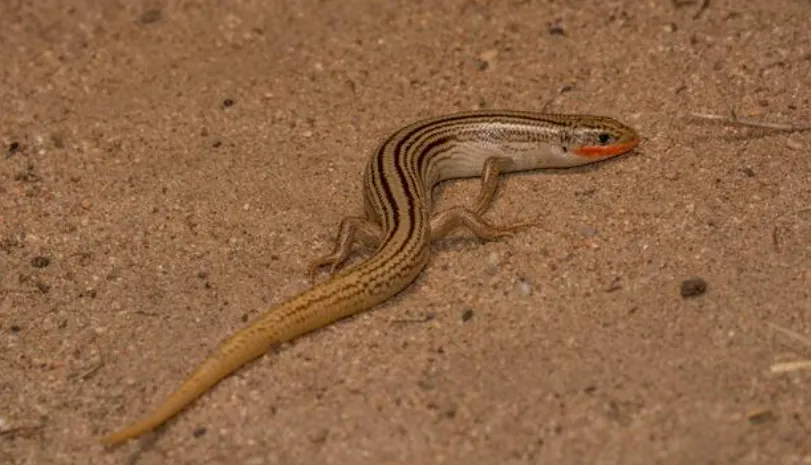
Scientific Information
- Scientific Name: Plestiodon multivirgatus
- Common Names: Many-Lined Skink, Variable Skink
Origins and Habitats
The Many-Lined Skink is native to the western United States, extending from the Great Basin to northern Mexico. Its preferred habitats include grasslands, sagebrush flats, and pine forests. This skink particularly likes sandy or rocky areas with plenty of ground cover to hide.
Physical Characteristics
Size:
- Male: Typically ranges from 5 to 8 inches in length.
- Female: Generally similar in size, between 5 to 8 inches.
Body Features:
Like other skinks, the Many-Lined Skink has a long, sleek body with short legs. It has smooth, shiny scales that are closely overlapping.
Coloration and Patterns:
This skink is named for its distinctive appearance: it has multiple light stripes running down the length of its body on a darker background. These stripes are usually white or yellowish, contrasting with the brown or blackish body color. Juveniles may have blue tails.
Diet
Many-Lined Skinks are insectivores, primarily feeding on various insects and spiders. Their diet includes beetles, ants, grasshoppers, and other small invertebrates.
Environmental Impact
As predators of insects and spiders, they play a role in controlling these populations, thereby contributing to the balance of their ecosystems. They also serve as prey for larger predators like birds and snakes.
Interesting Facts
- When threatened, the Many-Lined Skink can detach its tail to escape from predators. This self-amputation tactic distracts the attacker while the skink makes a getaway. The tail will eventually regrow.
- They are known to be quite agile and fast, making them challenging to catch for both predators and humans alike.
- Unlike many lizards that lay eggs, some populations of Many-Lined Skinks give birth to live young, a trait not so common among skinks.
25. Great Plains Skink (Plestiodon obsoletus)
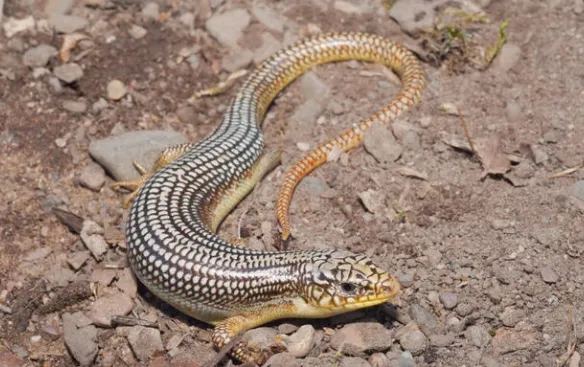
Scientific Information
- Scientific Name: Plestiodon obsoletus
- Common Names: Great Plains Skink
Origins and Habitats
The Great Plains Skink is native to the central United States, encompassing a range that spreads over the Great Plains from Nebraska to Texas. It predominantly thrives in grasslands, open woodlands, and the edges of forests. Loose soil, rocks, or logs which it can burrow under or hide amidst are key features of its habitat.
Physical Characteristics
Size:
- Male: Typically measures between 7 to 10 inches in length.
- Female: Generally similar in size, ranging from 6.5 to 9.5 inches.
Body Features:
The Great Plains Skink has a robust, elongated body. It possesses a broad head and a thick neck. Its legs are relatively short, and it has a tapering tail.
Coloration and Patterns:
Their scales are smooth and shiny. Adults usually exhibit a brown or olive color with faint dark stripes or patterns. The juveniles are more brightly colored with a blue tail and more prominent stripes.
Diet
These skinks are primarily insectivorous. They feed on a variety of invertebrates, including beetles, crickets, caterpillars, and spiders.
Environmental Impact
Great Plains Skinks play an essential role in their ecosystems as both predator and prey. By consuming insects and other small creatures, they help to maintain a balance in insect populations. Simultaneously, they are a
Interesting Facts
- Like many skinks, the Great Plains Skink can detach its tail if grabbed by a predator – a mechanism known as autotomy. Over time, the tail will regrow, though it may not be as long or perfectly formed as the original.
- These lizards are known to be secretive, spending a lot of time burrowed or hidden under debris. They are more likely to be seen during their active season in spring and early summer.
- Males can be territorial, especially during the breeding season, and might exhibit aggressive behaviors to ward off rivals.
26. Blue Spiny Lizard (Sceloporus cyanogenys)

Scientific Information
- Scientific Name: Sceloporus cyanogenys
- Common Names: Blue Spiny Lizard
Origins and Habitats
The Blue Spiny Lizard is primarily native to northeastern Mexico but also extends its range into southern Texas in the United States. This lizard is predominantly found in arid or semi-arid regions, particularly rocky outcrops, canyons, and scrubby woodlands.
Physical Characteristics
Size:
- Male: Generally larger, they can measure up to 11 inches from snout to the end of the tail.
- Female: Slightly smaller in size, averaging around 8 to 10 inches.
Body Features:
The Blue Spiny Lizard possesses a robust, muscular physique with strong limbs. It has rough, spiny scales that provide both protection and camouflage.
Coloration and Patterns:
Males are distinguished by their vibrant blue coloration on the throat, chest, and belly. They also have blue and black bands on their tails. Females and juveniles, on the other hand, are usually less vivid, often displaying more of a gray or brown hue with faint striping.
Diet
The Blue Spiny Lizard feeds on a variety of insects, including beetles, grasshoppers, and crickets. They also occasionally eat smaller lizards and plant material.
Environmental Impact
Serving as both predator and prey in their ecosystem, these lizards help regulate insect populations, ensuring they don’t overrun their habitat.
At the same time, they become
Interesting Facts
- Blue Spiny Lizards are known for their territorial nature, especially during mating seasons. Males often engage in displays to ward off rivals, which involves push-ups to display their vibrant blue underside.
- They possess keen eyesight and are diurnal, making them active hunters during the daytime.
- Like many lizards, they have the capability to shed their tail in defense against predators. This phenomenon, called autotomy, distracts the predator while the lizard makes its escape. Over time, the tail will regrow, though it might differ in appearance.
27. Rose-Bellied Lizard (Sceloporus variabilis)
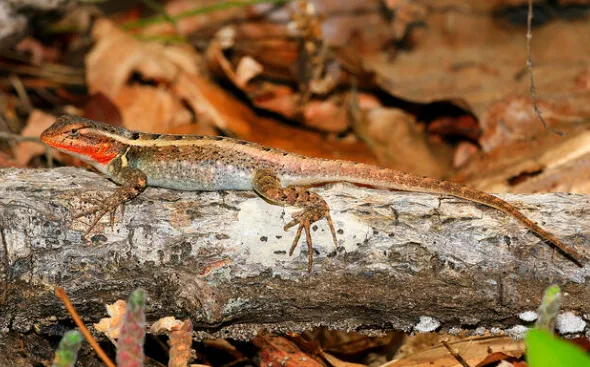
Scientific Information
- Scientific Name: Sceloporus variabilis
- Common Names: Rose-Bellied Lizard, Variable Lizard
Origins and Habitats
The Rose-Bellied Lizard is native to Central and North America, ranging from Mexico to Texas. Its preferred habitats include arid and semi-arid areas, such as scrubby grasslands, woodlands, and rock-strewn terrains where they can easily bask and hide.
Physical Characteristics
Size:
- Male: Typically between 5.5 to 7.5 inches from snout to tail tip.
- Female: Generally a bit smaller, measuring between 5 to 7 inches.
Body Features:
The Rose-Bellied Lizard has a somewhat robust body with strong limbs adapted for climbing and scampering across diverse terrains. The spiny scales provide both protection and camouflage.
Coloration and Patterns:
Males display a unique rose or pinkish hue on their bellies and throat, a signature trait which gives the species its common name. Their dorsal side usually showcases gray or brown with various patterns. Females are predominantly brown or gray with less vivid coloration and might possess faint striping or mottling.
Diet
Their diet mainly consists of insects such as beetles, ants, and spiders. They may also consume small plant materials or other smaller creatures when available.
Environmental Impact
In their ecosystem, Rose-Bellied Lizards play a dual role as both predators and prey. They help manage insect populations while also serving as a
Interesting Facts
- Rose-Bellied Lizards are known to engage in a series of push-ups, especially males during the breeding season, as a form of display to establish territory or attract a mate.
- When threatened, they can exhibit a startle display where they stand tall, arch their backs, and puff themselves up to appear larger and more intimidating.
- These lizards are also known to be good climbers, frequently found scaling trees, walls, and rocks.
28. Graphic Spiny Lizard (Sceloporus grammicus)
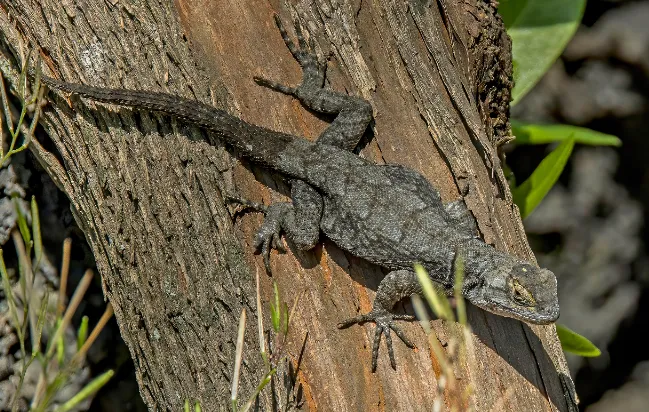
Scientific Information
- Scientific Name: Sceloporus grammicus
- Common Names: Graphic Spiny Lizard, Mesquite Lizard, Painted Spiny Lizard
Origins and Habitats
The Graphic Spiny Lizard is predominantly found in Central Mexico, with its range extending northwards into Texas. It is typically associated with rocky outcroppings, shrublands, and areas with abundant vegetation, offering both good basking spots and shelters.
Physical Characteristics
Size:
- Male: Typically measures between 5 to 6.5 inches in total length.
- Female: Slightly smaller, generally ranging from 4.5 to 6 inches.
Body Features:
This lizard is aptly named for its spiny, rough scales that cover its back and tail. Its body is robust with strong limbs, making it a proficient climber.
Coloration and Patterns:
The Graphic Spiny Lizard showcases an intricate pattern of crossbands and blotches on its dorsal side, which can be a mix of grays, browns, and greens. Some might even display a light blue coloration on their bellies and throats, especially prominent in males.
Diet
They primarily feed on a variety of insects, including beetles, grasshoppers, and ants. Occasionally, they might also consume small fruits or plant materials.
Environmental Impact
Within their habitat, Graphic Spiny Lizards play a significant role in controlling insect populations, thereby maintaining a balance in the ecosystem. On the flip side, they serve as a
Interesting Facts
- The Graphic Spiny Lizard is known to be a territorial creature. Males often engage in push-up displays to ward off rivals and attract females during mating seasons.
- When confronted by predators, they tend to flee rapidly, seeking shelter in crevices or under rocks.
- Their distinctive patterning not only provides them with excellent camouflage against predators but also aids in regulating their body temperature as they bask in sunlight.
29. Texas Spiny Lizard (Sceloporus olivaceus)

Scientific Information
- Scientific Name: Sceloporus olivaceus
- Common Names: Texas Spiny Lizard
Origins and Habitats
The Texas Spiny Lizard is native to the south-central United States, predominantly in Texas, and parts of northern Mexico. They are frequently found in woodlands, scrubby areas, and suburban gardens, often frequenting trees and shrubs.
Physical Characteristics
Size:
- Male: Typically measures between 7.5 to 11 inches in total length.
- Female: Generally ranges from 6.5 to 10 inches in total length.
Body Features:
The body of the Texas Spiny Lizard is covered with rough, pointed scales. It has long, slender legs, making it an agile climber.
Coloration and Patterns:
Their coloration is generally a mix of gray or brown with distinctive white or yellow stripes that run lengthwise on their bodies. These lizards also exhibit irregular blotching or mottling that aids in their camouflage.
Diet
Texas Spiny Lizards are primarily insectivores. They feed on a variety of insects such as beetles, crickets, ants, and spiders. They have also been observed consuming vegetation on occasion.
Environmental Impact
The Texas Spiny Lizard plays a significant role in local ecosystems by controlling insect populations. Additionally, they serve as prey for numerous predators, including birds of prey, snakes, and larger mammals.
Interesting Facts
- These lizards are skilled climbers and often seek refuge high up in trees or on vertical surfaces when threatened.
- Texas Spiny Lizards can perform “push-ups” as a display, especially during confrontations or during mating seasons to attract a mate.
- Their rough, spiky appearance might make them seem intimidating, but they are mostly harmless and will choose to flee rather than confront potential threats.
30. Canyon Lizard (Sceloporus merriami)
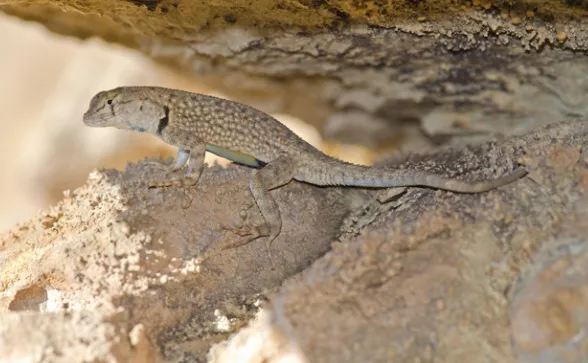
Scientific Information
- Scientific Name: Sceloporus merriami
- Common Names: Canyon Lizard, Merriam’s Spiny Lizard
Origins and Habitats
The Canyon Lizard is native to the southwestern region of the United States, particularly in Texas, and stretches down into northern Mexico. They prefer rocky outcroppings, canyons, and cliff faces where they can take advantage of crevices and cracks for shelter.
Physical Characteristics
Size:
- Male: Typically ranges from 5 to 7 inches in total length.
- Female: Generally slightly smaller, averaging between 4.5 to 6.5 inches in length.
Body Features:
The body of the Canyon Lizard is covered with keeled, rough scales. They have robust limbs adapted to their rocky environments, allowing them to be agile climbers.
Coloration and Patterns:
They display a gray to brown coloration with dark, crosswise bands or blotches, aiding them in blending seamlessly with their rocky surroundings.
Diet
The Canyon Lizard predominantly feeds on insects. Their diet comprises beetles, ants, spiders, and other small invertebrates that they find in their rocky habitats.
Environmental Impact
Within their ecosystems, Canyon Lizards play a vital role in controlling insect populations, which can become pests if left unchecked. They also serve as prey for various predators, including birds, snakes, and larger reptiles.
Interesting Facts
- Canyon Lizards, with their flattened bodies, are adept at squeezing into tight crevices to avoid predators.
- Their coloration provides them with an excellent camouflage against rocky backgrounds, making them hard to spot when they remain still.
- They have been known to display territorial behaviors, often using “push-up” displays to ward off intruding males or to attract females.
31. Crevice Spiny Lizard (Sceloporus poinsettia)
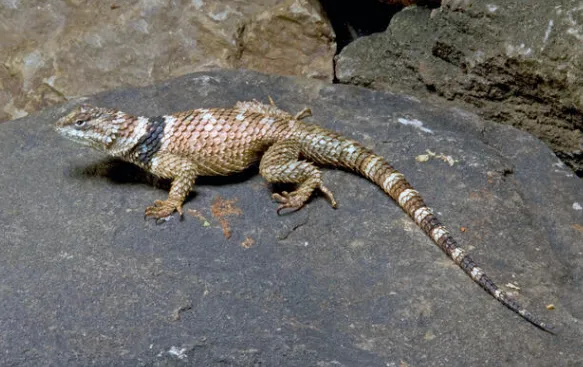
Scientific Information
- Scientific Name: Sceloporus poinsetti
- Common Names: Crevice Spiny Lizard, Poinsett’s Spiny Lizard
Origins and Habitats
The Crevice Spiny Lizard is endemic to the southwestern region of the United States, primarily in Texas, and extends into Mexico. Its preferred habitats include limestone outcroppings, rocky terrains, and cliff areas where they exploit the crevices and cracks as shelters.
Physical Characteristics
Size:
- Male: Typically ranges between 6 to 9 inches in total length.
- Female: Slightly smaller, with an average length of 5 to 8 inches.
Body Features:
Boasting keeled and spiny scales, their physique is robust, and they have strong limbs, enabling them to navigate and cling to rocky surfaces efficiently.
Coloration and Patterns:
Their dorsal side usually exhibits a gray to brownish-gray hue, ornamented with irregular dark crossbands. The ventral side tends to be a pale yellow or cream color. Males might exhibit blue patches on the abdomen and throat during mating seasons.
Diet
Crevice Spiny Lizards are insectivores. Their primary diet comprises insects like crickets, beetles, and ants. Occasionally, they might also consume spiders and other small invertebrates.
Environmental Impact
Serving as an ecological cornerstone in their habitats, Crevice Spiny Lizards help keep insect populations in check. They, in turn, become prey for a range of predators, from birds to larger reptiles.
Interesting Facts
- Named in honor of Joel Roberts Poinsett, an American physician and diplomat, the Crevice Spiny Lizard is also credited to his name. Poinsett introduced the poinsettia plant to the United States.
- Their primary defense strategy against predators is to swiftly dart into nearby rock crevices, leveraging their slender bodies.
- Males perform territorial displays similar to “push-ups” to assert dominance or attract potential mates.
32. Dunes Sagebrush Lizard (Sceloporus arenicolus)
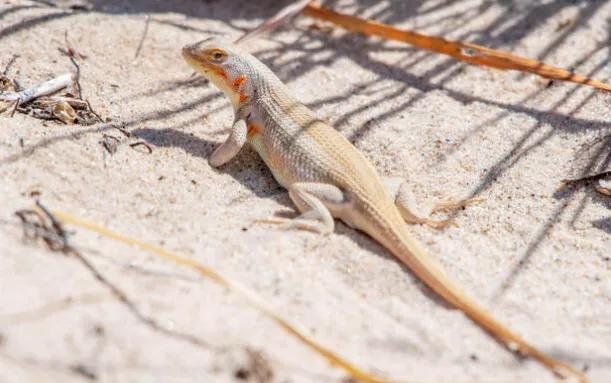
Scientific Information
- Scientific Name: Sceloporus arenicolus
- Common Names: Dunes Sagebrush Lizard, Sand Dune Lizard
Origins and Habitats
The Dunes Sagebrush Lizard is primarily found in the southwestern United States, specifically in parts of New Mexico and West Texas. It inhabits sandy dune habitats dominated by shinnery oak, a type of shrubby oak, from which it derives its common name. These specialized habitats are crucial for the lizard’s survival.
Physical Characteristics
Size:
- Male: Generally measures between 2.5 to 3 inches in snout-vent length.
- Female: Slightly smaller, averaging around 2 to 2.7 inches in snout-vent length.
Body Features:
The Dunes Sagebrush Lizard possesses a streamlined body with fringed toes, adaptations that assist in moving swiftly through its sandy environment.
Coloration and Patterns:
Exhibiting a sandy color that closely matches its environment, this lizard often has faint striping down its back. The hue allows the lizard to camouflage effectively in its surroundings.
Diet
The Dunes Sagebrush Lizard primarily feeds on small insects like ants, beetles, and spiders, making them an essential factor in controlling local insect populations.
Environmental Impact
Within their unique habitat, these lizards play a pivotal role in the
Interesting Facts
- Due to habitat loss, mainly because of oil and gas development and sand shinnery oak removal, the Dunes Sagebrush Lizard’s population has seen a decline, leading to conservation concerns.
- These lizards are known to bury themselves in the sand to escape from predators or to regulate their body temperature during the heat of the day.
- The Dunes Sagebrush Lizard’s habitat is so specific that even minor alterations to its environment can have significant impacts on its population.
33. Prairie Lizard (Sceloporus consobrinus)
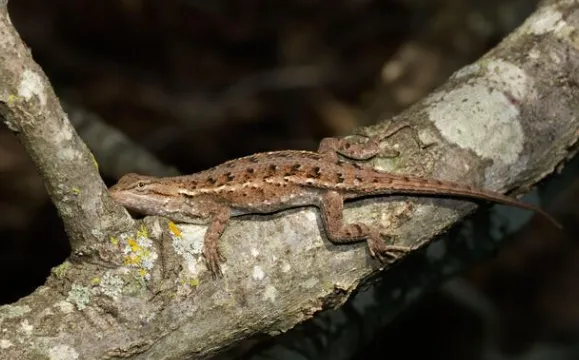
Scientific Information
- Scientific Name: Sceloporus consobrinus
- Common Names: Prairie Lizard, Fence Lizard
Origins and Habitats
Native to the central United States, the Prairie Lizard predominantly inhabits regions stretching from Nebraska to Texas. As the name implies, they favor prairies but are also commonly found in woodlands, brushy areas, and even alongside fences in rural settings.
Physical Characteristics
Size:
- Male: Typically measures between 2.5 to 4.5 inches in snout-vent length.
- Female: Ranges from 2.2 to 4 inches in snout-vent length.
Body Features:
The Prairie Lizard boasts a sturdy and slightly flattened body with rough, keeled scales. Its tail is long and tapering, and its legs are well-suited for quick movements.
Coloration and Patterns:
The Prairie Lizard’s dorsal side is generally gray to brown, often with wavy crossbands. Males might showcase blue patches on their bellies and throats, especially during the mating season, while females tend to have more subdued coloration.
Diet
They are primarily insectivorous, consuming a diet of beetles, crickets, spiders, and other small invertebrates.
Environmental Impact
Prairie Lizards play a role in regulating insect populations in their habitats. Additionally, they serve as a
Interesting Facts
- When threatened, Prairie Lizards are known to scurry up trees, fences, or other vertical surfaces to escape predators.
- During courtship, male Prairie Lizards perform “push-up” displays to attract females and establish territory.
- Like other lizards, Prairie Lizards can autotomize, or self-amputate, their tails as a defensive strategy. Over time, they can regrow a new tail, though it might not be as long or colorful as the original.
34. Plateau Spotted Whiptail (Aspidoscelis scalaris)
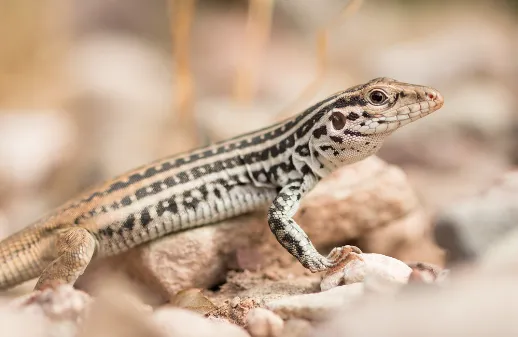
Scientific Information
- Scientific Name: Aspidoscelis scalaris
- Common Names: Plateau Spotted Whiptail
Origins and Habitats
The Plateau Spotted Whiptail can be found in the south-central United States and northeastern Mexico. Its preferred habitats include desert scrublands, grasslands, and rocky terrains, particularly in areas with loose, sandy soils.
Physical Characteristics
Size:
- Male: Typically measures between 2.7 to 3.9 inches in snout-vent length.
- Female: Ranges from 2.5 to 3.5 inches in snout-vent length.
Body Features:
This slender, elongated lizard has a tail that’s often more than twice the length of its body. Its limbs are well-developed, allowing for rapid movements.
Coloration and Patterns:
As the name suggests, the Plateau Spotted Whiptail is characterized by dark spots on its upper body, contrasted against a lighter background, typically brown or greenish-brown. These spots can sometimes merge to form partial or full stripes.
Diet
Their diet is largely insectivorous, consisting of ants, beetles, termites, and other small invertebrates.
Environmental Impact
Serving as a natural pest controller by feeding on insects, the Plateau Spotted Whiptail helps maintain the balance in its ecosystem. Furthermore, they are a prey species for various predators, such as birds, snakes, and larger lizards.
Interesting Facts
- An interesting trait of many whiptail species, including the Plateau Spotted Whiptail, is that some populations are all-female and reproduce through parthenogenesis, a form of asexual reproduction.
- These lizards are known to be diurnal and are most active during the warmer parts of the day.
- When threatened, they can move exceptionally fast, often darting into burrows or under vegetation to escape predators.
35. Gray Checkered Whiptail (Aspidoscelis dixoni)
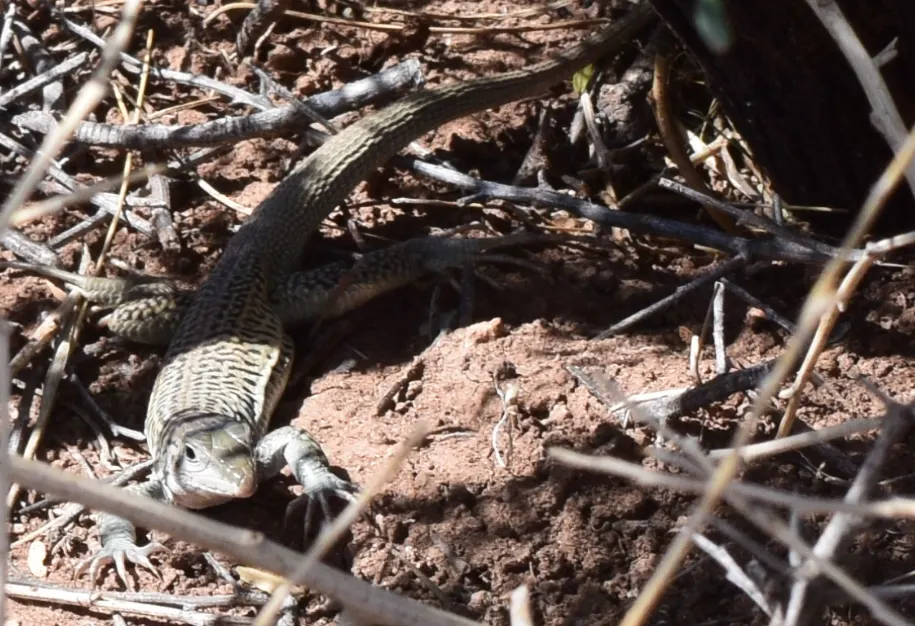
Scientific Information
- Scientific Name: Aspidoscelis dixoni
- Common Names: Gray Checkered Whiptail
Origins and Habitats
Native to the deserts and scrublands of northern Mexico, the Gray Checkered Whiptail can also be found in certain parts of Texas. They prefer sandy or loose soils, often amidst brushy vegetation or in open spaces, where they can quickly maneuver to catch prey or evade predators.
Physical Characteristics
Size:
- Male: Typically measures between 2.5 to 3.5 inches in snout-vent length.
- Female: Ranges from 2.3 to 3.3 inches in snout-vent length.
Body Features:
These lizards are agile with a slender body and a long tail, which often exceeds the body’s length. Their limbs are well-adapted for swift movement on sandy terrains.
Coloration and Patterns:
True to their name, the Gray Checkered Whiptail has a grayish background color interspersed with a checkered or reticulated pattern of darker gray or black spots. The underbelly is typically pale or whitish.
Diet
The Gray Checkered Whiptail primarily feeds on small insects, including ants, beetles, and spiders. Their keen eyesight and speed make them effective hunters in their habitat.
Environmental Impact
They play a key role in controlling insect populations, which helps maintain the balance of the ecosystem. Their presence also serves as a
Interesting Facts
- Much like other whiptails, certain populations of Gray Checkered Whiptail are parthenogenetic, meaning they reproduce asexually, without males.
- The Gray Checkered Whiptail is known for its skittish nature, often darting away at high speeds if approached or threatened.
- Their swift movement and agility make them difficult prey, even for birds and snakes.
36. Chihuahuan Spotted Whiptail (Aspidoscelis exsanguis)
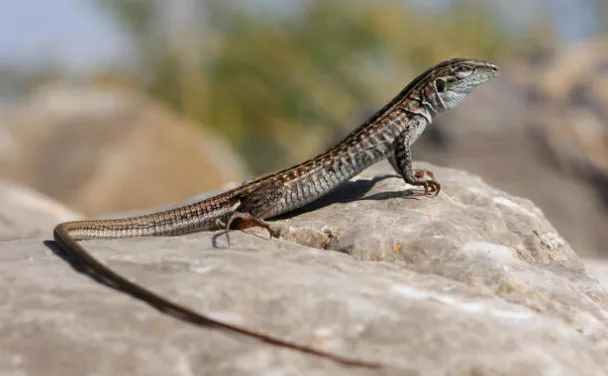
Scientific Information
- Scientific Name: Aspidoscelis exsanguis
- Common Names: Chihuahuan Spotted Whiptail
Origins and Habitats:
The Chihuahuan Spotted Whiptail is primarily found in the Chihuahuan Desert, spanning parts of northern Mexico and the southwestern United States, including Texas. Its habitats include desert grasslands, shrublands, and open woodlands, particularly areas with loose soil for burrowing.
Physical Characteristics
Size:
- Male: Typically measures between 2.7 to 3.5 inches in snout-vent length.
- Female: Ranges from 2.6 to 3.4 inches in snout-vent length.
Body Features:
The lizard has a slender body, elongated tail, and well-developed limbs that provide agility and speed, crucial for both hunting and evasion.
Coloration and Patterns:
Chihuahuan Spotted Whiptails have a light brown or tan background coloration dotted with dark brown or black spots across their backs. The pattern often gives a speckled appearance, which becomes more distinct during the breeding season. Their underbellies are typically whitish or pale yellow.
Diet
These lizards are primarily insectivores, feasting on a variety of small insects such as ants, beetles, spiders, and other arthropods. Their agility and keen eyesight aid in capturing their quick-moving prey.
Environmental Impact
In their natural habitat, Chihuahuan Spotted Whiptails play a role in controlling insect populations, thus ensuring a balance in the ecosystem. They also serve as prey for larger predators, contributing to the intricate
Interesting Facts
- Like several whiptail species, certain populations of the Chihuahuan Spotted Whiptail reproduce through parthenogenesis. This means they can reproduce asexually, and populations can consist entirely of females.
- When threatened, these lizards can autotomize or shed part of their tail to distract predators, allowing them to escape. The tail regenerates over time.
- Their active periods coincide with the warmer parts of the day, often seen basking in the sun or darting about in search of
food .
37. Common Checkered Whiptail (Aspidoscelis tesselata)
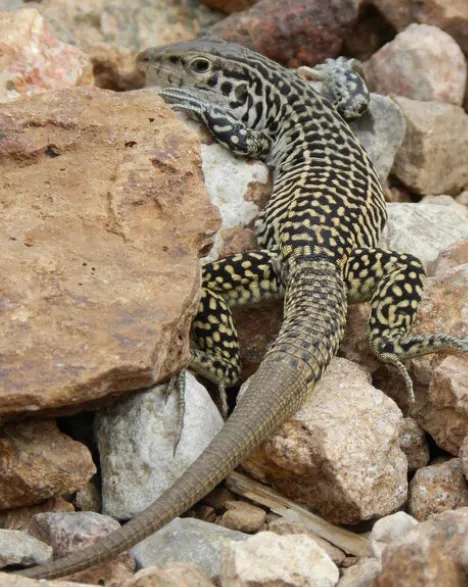
Scientific Information
- Scientific Name: Aspidoscelis tesselata
- Common Names: Common Checkered Whiptail
Origins and Habitats
The Common Checkered Whiptail is indigenous to the southwestern United States, including Texas, and extends into northern Mexico. This lizard is versatile and inhabits a wide range of environments such as grasslands, desert areas, rocky terrains, and shrublands. The presence of loose soil is beneficial as it offers opportunities for burrowing.
Physical Characteristics
Size:
- Male: Typically measures between 2.8 to 3.7 inches in snout-vent length.
- Female: Slightly larger, usually ranging from 3.0 to 3.9 inches in snout-vent length.
Body Features:
This species possesses a slender and elongated body with a lengthy tail. The tail and strong limbs facilitate swift movements essential for hunting and escaping predators.
Coloration and Patterns:
True to its name, the Common Checkered Whiptail has a checkered pattern, with dark black or brown crossbands on a lighter background, which could be greenish, grayish, or brown. The pattern is more intricate and distinct along the back, fading slightly on the sides. The underbelly usually ranges from pale white to cream.
Diet
Predominantly insectivorous, the Common Checkered Whiptail feeds on a mix of ants, beetles, spiders, and other small invertebrates. Its swift and agile nature assists it in catching its typically fast-moving prey.
Environmental Impact
Within their ecosystems, Common Checkered Whiptails act as natural pest controllers by feeding on a myriad of insects. However, they also serve as prey to larger predators, playing a dual role in the
Interesting Facts
- Parthenogenesis is a mode of reproduction employed by some populations of Common Checkered Whiptail. This means they can reproduce asexually without males, leading to populations that can be composed entirely of females.
- When sensing danger, these lizards can detach a portion of their tail, a tactic to divert the attention of predators. Over time, the tail will regenerate, though it might not reach its original length.
- Their vibrant checkered pattern not only provides them with camouflage but also aids in thermoregulation by reflecting sunlight and preventing overheating.
38. Texan Spotted Whiptail (Aspidoscelis gularis)
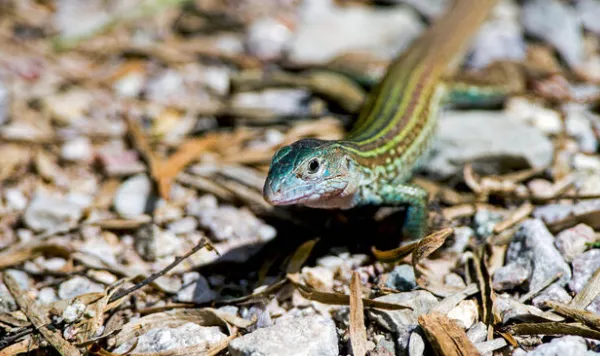
Scientific Information
- Scientific Name: Aspidoscelis gularis
- Common Names: Texan Spotted Whiptail
Origins and Habitats
The Texan Spotted Whiptail is native to the southern parts of the United States, particularly Texas, and can also be found in northeastern Mexico. It predominantly prefers semi-arid regions, open grasslands, scrubby areas, and woodlands. It is also commonly observed in disturbed habitats, like roadsides or cultivated fields.
Physical Characteristics
Size:
- Male: Typically measures between 3.0 to 4.5 inches in snout-vent length.
- Female: Generally ranges from 3.2 to 4.7 inches in snout-vent length.
Body Features:
This lizard boasts a slender physique with a notably long tail, proportionally representing almost two-thirds of its total length. Their strong limbs are well-adapted for rapid movements.
Coloration and Patterns:
The Texan Spotted Whiptail exhibits a series of 6-8 light-colored longitudinal stripes on a darker background, often brownish or black. These stripes run from the neck down to the tail. The lizard’s sides may have a series of white spots, giving it its “spotted” moniker. The belly is usually pale white or yellowish.
Diet
The diet of the Texan Spotted Whiptail mainly consists of insects, including ants, beetles, and spiders. They are also known to consume some plant material occasionally, though they are primarily insectivores.
Environmental Impact
The Texan Spotted Whiptail serves as an integral part of its ecosystem. By feeding on insects, it helps in regulating insect populations. Simultaneously, being a medium-sized lizard, it serves as prey for many predators, ensuring the balance of the
Interesting Facts
- Like other whiptails, Texan Spotted Whiptails can drop and later regenerate their tails as a defense mechanism against predators.
- This species exhibits a keen sense of vision and can detect the slightest of movements, aiding them in hunting their prey.
- During the hottest parts of the day, the Texan Spotted Whiptail might be found taking refuge under rocks, logs, or in burrows to avoid extreme temperatures.
39. Little Striped Whiptail (Aspidoscelis inornate)
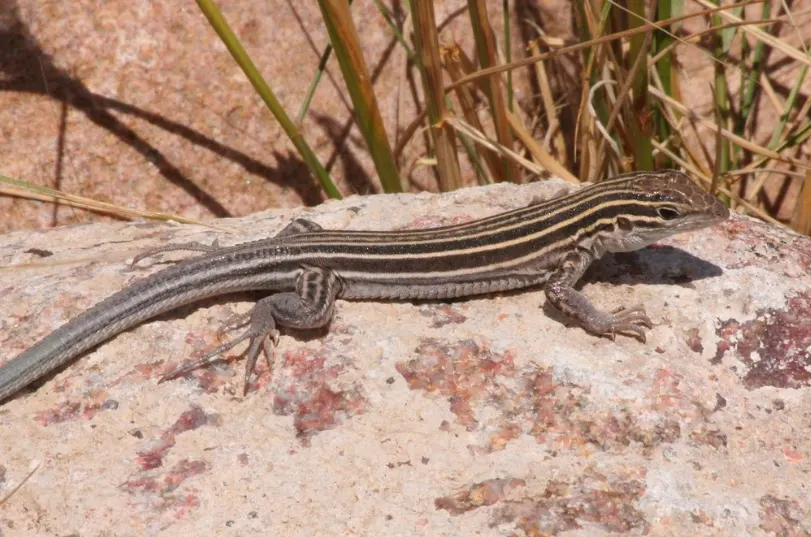
Scientific Information
- Scientific Name: Aspidoscelis inornate
- Common Names: Little Striped Whiptail
Origins and Habitats
The Little Striped Whiptail is native to the southwestern parts of the United States, including Texas, New Mexico, Arizona, and parts of southern Colorado. This species thrives in semi-arid environments, grasslands, shrublands, and desert areas. They often inhabit sandy soils and areas with sparse vegetation.
Physical Characteristics
Size:
- Male: Typically measures between 2.5 to 3.5 inches in snout-vent length.
- Female: Generally, ranges from 2.8 to 3.7 inches in snout-vent length.
Body Features:
Little Striped Whiptails have a slender and streamlined body, making them adept runners. Their long tail can be about twice the length of their body.
Coloration and Patterns:
As the name suggests, the Little Striped Whiptail has light-colored stripes that run longitudinally down its dark-colored body. These stripes begin from the neck and extend to the tail. The belly is generally pale, often cream or light gray.
Diet
Their primary diet consists of insects, especially ants, beetles, and termites. They are also known to eat spiders and occasionally some plant matter.
Environmental Impact
Little Striped Whiptails play a crucial role in their ecosystems. Their insectivorous diet aids in controlling insect populations. At the same time, they serve as prey for various larger animals, such as birds of prey, snakes, and larger lizards, thus maintaining the ecological balance.
Interesting Facts
- Whiptails, including the Little Striped Whiptail, are known for their fast speeds and can swiftly run to evade predators or to catch prey.
- Certain Aspidoscelis groups exhibit parthenogenesis, where females have the ability to produce offspring without any male involvement. Nonetheless, the Little Striped Whiptail is usually known to reproduce through traditional mating methods.
- They have keen eyesight and are highly alert, often flicking their tongue out to sense their environment.
40. Six-Lined Racerunner (Aspidoscelis sexlineata)
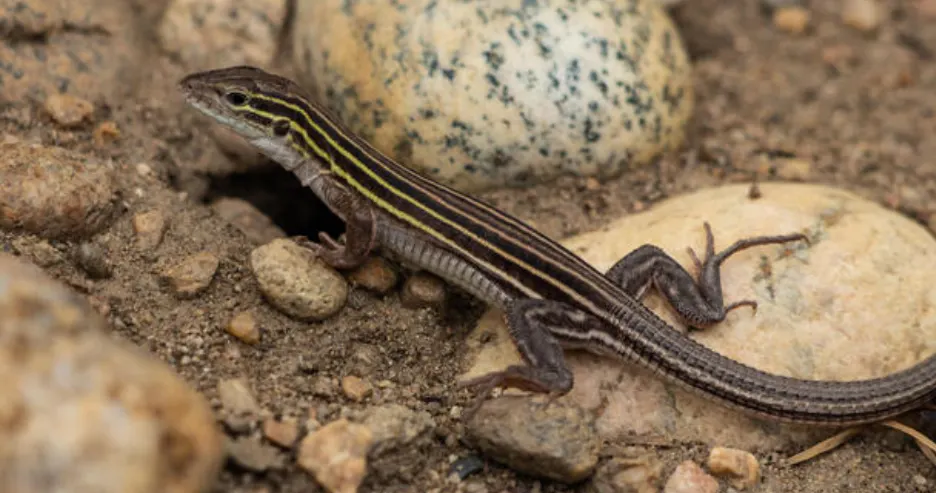
Scientific Information
- Scientific Name: Aspidoscelis sexlineata
- Common Names: Six-Lined Racerunner
Origins and Habitats
The Six-Lined Racerunner is native to the eastern and central regions of the United States, spanning from Florida to South Dakota and westward to Arizona. It thrives in sandy, open habitats, including grasslands, coastal dunes, and rocky outcrops. These lizards prefer areas with ample sunlight, making them a common sight in fields and pastures.
Physical Characteristics
Size:
- Male: Typically range from 6.5 to 8.5 inches in length.
- Female: Slightly smaller, generally between 5.5 and 7.5 inches.
Body Features:
The Six-Lined Racerunner has a slender body, a pointed snout, and long legs which are well-adapted for swift movements.
Coloration and Patterns:
As the name suggests, this lizard sports six distinct light-yellow to greenish stripes running down its dark-colored back, from behind the eyes to the base of the tail. Its underside is usually pale white or light blue, and the males may have a bright blue or green tint on the throat, especially during the breeding season.
Diet
Six-Lined Racerunners are primarily insectivores. Their diet consists of a range of insects, including beetles, crickets, grasshoppers, and ants. Their quick agility allows them to chase and catch these insects with ease. Occasionally, they might also consume spiders and other small invertebrates.
Environmental Impact
In their natural habitats, Six-Lined Racerunners play an important role in maintaining a balance in insect populations. They help control potentially harmful insect numbers, thus benefiting the ecosystem. However, habitat loss due to human activities can threaten their populations.
Interesting Facts
- One of the notable behaviors of the Six-Lined Racerunner is its ability to “race” at impressive speeds, making them one of the fastest lizards in their range.
- When threatened, they can shed their tail to distract predators, allowing them to make a speedy escape. Over time, the tail regrows, though it might not achieve its original length.
- They are known to be more active during the hotter parts of the day, often seen basking in the sun to regulate their body temperature.
Q&A Section
Q: Are there lizards in Texas?
A: Yes, Texas is home to a variety of lizard species.
Q: What lizards live in Texas?
A: Texas hosts a diverse range of lizards, from the Texas horned lizard to the green anole.
Q: What reptiles live in Texas?
A: Texas has a rich reptilian biodiversity that includes lizards, snakes, turtles, and alligators.
Q: Are there any poisonous lizards in Texas?
A: While there are venomous lizards, like the Gila monster, in the US, they are not native to Texas.
Q: What are the invasive lizards in Texas?
A: Some non-native species have established populations in Texas, impacting local ecosystems.
Q: Are there lizards in Austin, Texas?
A: Yes, Austin, like the rest of Texas, is home to many lizard species.
Q: What are the spiked lizards of Texas?
A: The Texas horned lizard is one of the most recognizable spiked lizards native to Texas.
Q: Do spiny lizards bite?
A: While spiny lizards can bite if threatened or handled, their bites are usually not harmful to humans.
Q: Do spiny lizards hiss?
A: Some lizards hiss as a defensive mechanism, but it varies by species.
Q: Why are Texas horned lizards important?
A: They play a vital role in the ecosystem by controlling insect populations and serving as prey for larger predators.
Q: What do Texas Spiny Lizards do in winter?
A: These lizards usually brumate, a form of hibernation, during the colder months.
Q: How do you catch a Texas spiny lizard?
A: Care should be taken when attempting to catch any wild animal. It’s recommended to observe them in their natural habitat.
Q: Why does the Texas horned lizard have a sticky tongue?
A: The sticky tongue helps them catch and consume ants, which are a primary part of their diet.
Q: Why does the Texas horned lizard shoot blood?
A: This is a defense mechanism. When threatened, they can squirt blood from their eyes to deter predators.
Q: Are horned lizards protected in Texas?
A: Yes, the Texas horned lizard is a threatened species and is protected by law.
Q: Why is the Texas horned lizard endangered?
A: Factors like habitat loss, pesticide use, and the introduction of invasive species have contributed to their decline.
Q: How can we get rid of brown anoles?
A: Brown anoles are invasive in some areas. Consult local wildlife experts for safe removal methods.
Q: Are Texas spiny lizards safe?
A: They are not harmful to humans but should be handled with care.
Q: Are Texas spiny lizards friendly?
A: Like many wild animals, they can be stressed when handled. It’s best to observe from a distance.
Q: Can you keep a crevice spiny lizard as a pet?
A: While possible, always ensure you have the right habitat and consult with herpetology experts.
Q: Do uromastyx lizards make good pets?
A: Uromastyx can make good pets for those prepared for their specific care requirements.
Q: Are monitor lizards in Texas?
A: Monitor lizards are not native to Texas, but some species may be kept as pets or could become invasive.
- Enchi Ball Python: A Unique and Stunning Morph of Python regius - March 27, 2025
- Emerald Tree Monitor: The Enigmatic Green Guardian of the Rainforest - March 26, 2025
- The Egyptian Cobra (Naja haje): A Fascinating Serpent - March 25, 2025
